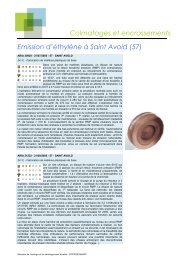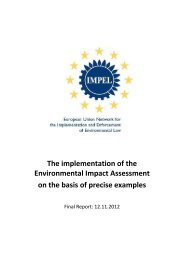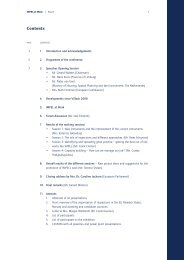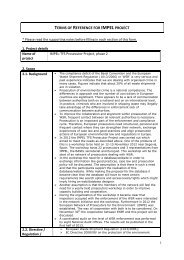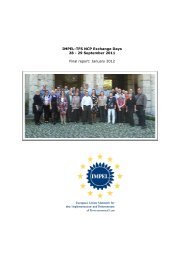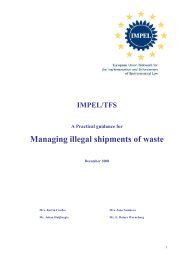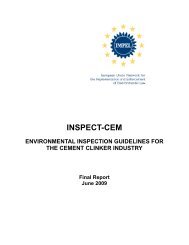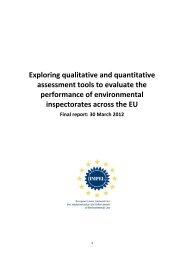2009-09 - IRI Portugal - FINAL REPORT - IMPEL
2009-09 - IRI Portugal - FINAL REPORT - IMPEL
2009-09 - IRI Portugal - FINAL REPORT - IMPEL
You also want an ePaper? Increase the reach of your titles
YUMPU automatically turns print PDFs into web optimized ePapers that Google loves.
1c. Defining objectives and strategies<br />
Overview<br />
The strategic objectives of the Activity Plan are agreed between the Heads of Unit and<br />
the Inspector General and Deputy Inspector General. They relate to MAOTDR policy and<br />
to the Environmental Services campaigns. There is a logical order of sub-objectives (a<br />
mixture of outputs and environmental outcomes) that are focused and clearly linked to<br />
the Ministry targets. Once the strategic objectives are agreed, Heads of Units typically<br />
devolve down responsibility of specific sub-objectives to individual inspectors. This is<br />
also built into the personal objectives of inspectors. The review team noted that this<br />
fostered a good team spirit and created a strong ‘line of sight’ linking corporate goals<br />
with individual goals so that each inspector could see how they contribute to their<br />
organisation’s targets.<br />
IGAOT does not use multi-year objectives. The review team suggested that by using<br />
multi-year objectives, perhaps over a 3-5 year period, more effective comparison could<br />
be made about longer term improvements in environmental outcomes as it is difficult to<br />
see results in only one year.<br />
When defining objectives and targets, IGAOT considered the following:<br />
• The <strong>20<strong>09</strong></strong> Annual Activity Plan took into account the Guidance Book “Doing the<br />
Right Things III” for the three environmental inspection services.<br />
• In 2008 the Risk Assessment database was still being developed. The objectives<br />
and targets that were set for <strong>20<strong>09</strong></strong> were therefore not associated to the<br />
outcomes of the risk assessment. For 2010 the objectives and targets will be<br />
based in the priorities that were set through Risk Assessment.<br />
• The objectives were defined according to the prioritisation criteria and took into<br />
consideration sensitive location areas and certain problematic activity sectors.<br />
Inspection strategies:<br />
The following interventions are used by the IGAOT<br />
• Postal notifications – These installations are not a priority to be inspected and so<br />
compliance can be checked by written documentation sent through the post by<br />
the operator. The main advantage is that it can target a large number of<br />
installations at once and therefore inspections can be targeted at non-compliant<br />
operators or the operators that did not answer the postal forms.<br />
• Sampling campaigns - for example, river sampling campaigns allow an evaluation<br />
of water quality which helps to identify pollutants and assists enforcement<br />
actions against identified operators.<br />
• Intervention strategies will be further developed in a workshop in December<br />
<strong>20<strong>09</strong></strong>, under the Protocol of bilateral cooperation between <strong>Portugal</strong> and the<br />
Netherlands.<br />
22



